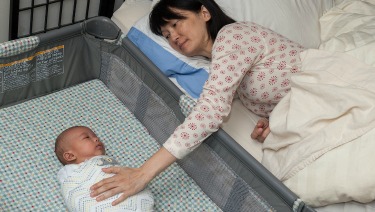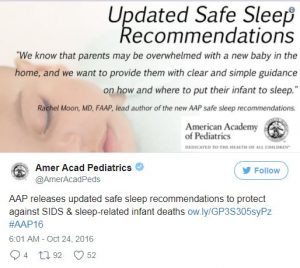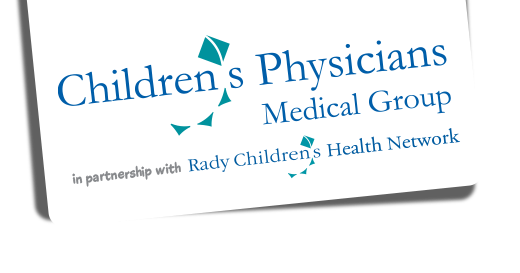
*Updated 06/06/2017
All parents have been there. You get home, after giving birth, with a newborn who needs to be fed every 2-3 hours day and night. It’s exhausting. Many moms and dads find that sleeping with their baby is the best way to get sleep. But is it the safest?
This is what we know:
- Babies are at highest risk of Sudden Infant Death Syndrome (SIDS) for the first 6 months of life
- Back sleeping decreases the risk of SIDS, but so does breastfeeding
- Co-sleeping can increase the risk of SIDS when certain factors are present, as well as increase the risk of sleep-related death like strangulation or suffocation
- BUT…co-sleeping also increases breastfeeding rates
So what is a new parent to do? One can see how confusing this is. In order to minimize the risk of sleep-related death and SIDS, the American Academy of Pediatrics came out in the past with a recommendation AGAINST all bed-sharing. The recommendation is to feed your baby and then move him/her to a bassinet or crib next to the bed and put them to sleep on a firm mattress on their back. Unfortunately, this recommendation led to more parents sleeping in chairs or on sofas with their newborns in order to avoid the bed. Well that is even worse! There is an 18X greater risk of sleep-related death if co-sleeping on a sofa or chair. Never sleep on the couch with your newborn!
Now the AAP has updated it’s recommendations to further support parents while also ensuring the safest sleep environment for babies. These recommendations are also more in-line with what the Academy of Breastfeeding Medicine has stated in the past, although the AAP still recommends co-sleeping in the same room (room sharing) as opposed to bed-sharing. At an Academy of Breastfeeding Medicine conference in the fall of 2014, the question of whether or not a breastfed baby can bed share was explored. In the most optimal situation, the answer is yes. However, most situations are not optimal and most sleep related deaths are due to these less than optimal situations. Meaning, the majority of sleep related death (SIDS and strangulation/suffocation) are preventable. The risks of bed-sharing as stated by the ABM are as follows:
- Bed-sharing with a smoker
- Bed-sharing with a mother who smoked during pregnancy
- Bed-sharing with someone who is excessively tired
- Bed-sharing with someone who is under the influence of drugs or alcohol, or a medication that impairs alertness
- Sleeping on a soft surface, waterbed, couch or chair
- Sleeping on pillows or heavy blankets
- Stomach sleeping
- Formula feeding
- Being unimmunized
Now I know what you are thinking, most new parents are excessively tired and most modern day beds are soft or pillow top. Therefore, it is likely that the risk of bed-sharing is greater than the benefit and it is important to weigh these risks and benefits before you share a bed with your infant. The risks of death are very real and should not be taken lightly.
According to the AAP, the optimal sleep environment involves the same risk reduction as stated above with a few additions. Besides back sleeping, using a firm mattress, keeping soft objects away from infants, avoiding sleep next to a smoker or someone under the influence of alcohol, breastfeeding and immunizing; the AAP also recommends the use of pacifiers if the infant will take it, having the infant room share in a separate crib (for 6 months to a year), avoiding commercial additions to the crib like wedges, avoiding the use of cardio respiratory monitors and avoiding overheating. Something that is also new from the AAP is the recommendation that if mom does fall asleep feeding the baby in bed, make sure to remove all soft bedding, blankets and pillows from the area and when mom wakes up she is to place baby back in his/her separate bassinet or crib.
Because everyone is healthier and happier with a good night’s sleep, I typically recommend sleep training (teaching a baby to fall asleep on his/her own) between 4 and 6 months of age. As you can imagine, this is hard to do with baby in the room. It is easier for mom and dad to immediately soothe baby while room sharing, in turn teaching baby to continue waking over night. Therefore, if you feel as if you are ready to sleep train so everyone can get better sleep, it’s time to weigh the risks v benefits of room sharing. Remember, the guidelines suggest to room share for 6-12 months so over 6 months when the risk of SIDS drops off, it can be an option to move baby to a separate room.

It’s always best to discuss your sleep options with your pediatrician and to, again, weigh the risks and benefits. When in doubt, move your baby to a firm mattress in a separate crib next to your bed and place him/her on their back. Never use a bumper or surround your baby with extra blankets. Remember, when it comes to cribs, bare is best!
Good night and sleep tight (safely)!
5 thoughts on “Safe sleep for infants”
Leave a Reply








Nice article. My baby never slept well (especially at night) until I started using the HWL method by Susan Urban from her “How to teach a baby to fall asleep alone” ebook from her website: http://www.parental-love.com – by far one of the best things I’ve ever got my hands on to get him to fall asleep quickly and without rocking him to sleep. Can’t imagine life without it now! I heard about it at a playground when women were talking about how great it is!
Hi Olivia, thank you for your comments, we appreciate your input!
thank you Olivia for mentioning Urban’s guide. After reading your post my husband and I decided to follow the guide and now our boy falls asleep on his own and there is no need to rock him for 30 minutes like we used to do it. We are finally well rested. Thanks a lot!
I once tried to let my baby is sleeping on the crib. When I was too tired, I couldn’t wake up frequently to check her up. Once, she was covered up with her blanket, and I was so shocked at first! Then I kept her beside me, though it caused me to suffer from sleep deprivation. Hmm, did you experience similar things?
That is why keeping blankets out of the crib is so important.